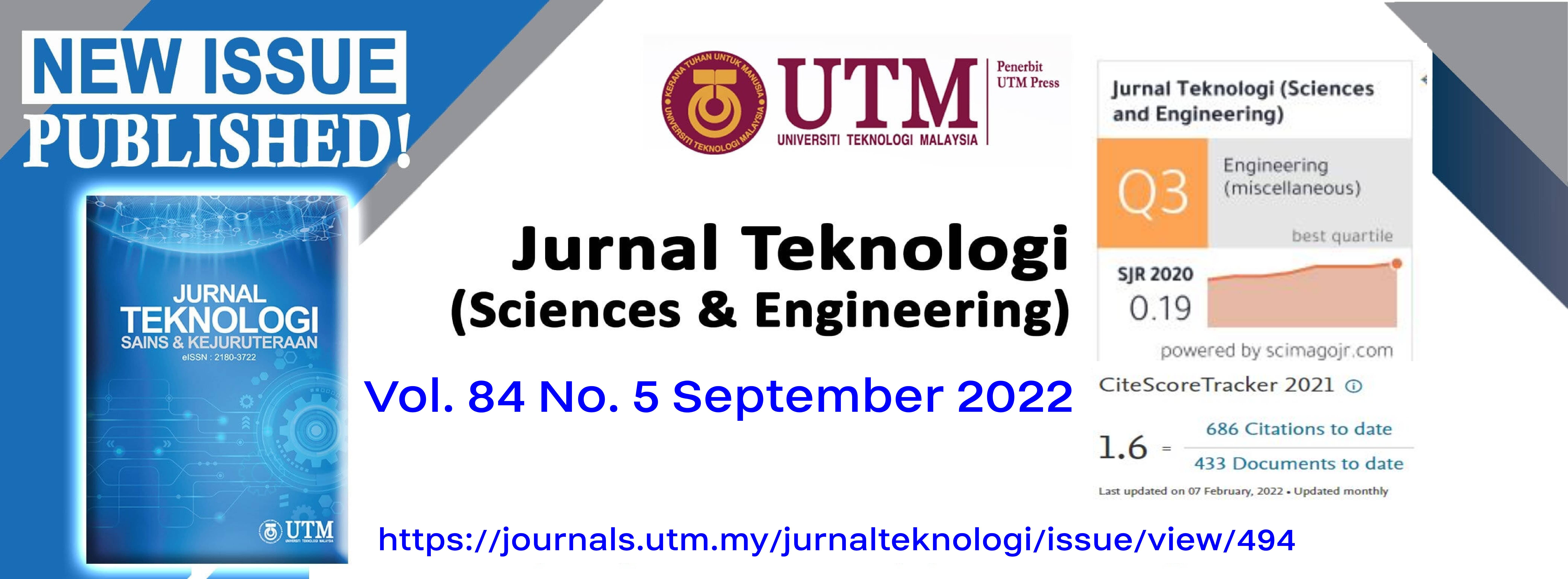EFFECT OF CLAY SHALE SHEAR STRENGTH DEGRADATION ON BORED PILE FRICTION IN CLAY SHALE
DOI:
https://doi.org/10.11113/jurnalteknologi.v84.18220Keywords:
Clay shale, bored pile friction, shear strength degradation, weathering, direct shearAbstract
This research aims at investigating and modeling the axial bearing capacity degradation of a bored pile on clay shale due to the bored pile installation processes. Clay shale sample models were prepared to simulate the wetting and drying cycles through weathering process between 0 to 6 hours. All samples were tested in which every 1 hour of the weathering process representing 1 cycle of wetting and drying. The direct shear laboratory tests were performed to obtain the peak and residual shear strength parameters of the interface between the bored pile and clay shale. The peak and residual shear strength parameters were obtained after 6 hours of the weathering process. The residual shear strength parameters were measured by applying with and without stress release. This investigation showed that the shear strength degradation at peak, residual without stress release, and residual with stress release respectively reached 87-62%, 28-20%, and 25-14% after 1 to 6 hours of weathering process. This result is very useful for predicting the bored pile skin friction in clay shale soils.
References
Irsyam, M., Sahadewa, A., Boesono, A., and Soebagyo. 2007. Pengaruh Strength Reduction Tanah Clay-Shale Akibat Pelaksanaan Pemboran Terhadap Nilai Daya Dukung Pondasi Tiang di Jembatan Suramadu Berdasarkan Analisis Hasil Tes OC. Jurnal Teknik Sipil. 14(2): 69-82.
DOI: 10.5614/jts.2007.14.2.1.
Labiouse V. and Vietor T. 2014. Laboratory and In Situ Simulation Tests of the Excavation Damaged Zone Around Galleries in Opalinus Clay. Rock Mechanics and Rock Engineering. 47: 57-70.
DOI: 10.1007/s00603-013-0389-4.
Kupferschmied, N., Wild, K. M., Amann, F., Nussbaum, C., Jaeggi, D., and Badertscher, N. 2015. Time-dependent Fracture Formation Around a Borehole in a Clay Shale. International Journal of Rock Mechanics & Mining Sciences. 77: 105-114.
DOI: 10.1016/j.ijrmms.2015.03.027.
Pašić, B., Međimurec, N.G, Matanović, D. 2007. WELLBORE INSTABILITY: Causes and Consequences Nestabilnost Kanala Bušotine: Uzroci I Posljedice. Rudarsko-Geološko-Naftni Zbornik. 19: 87-98.
Lisjak, A., Grasselli, G., and Vietor, T. 2014. Continuum–Discontinuum Analysis of Failure Mechanisms Around Unsupported Circular Excavations in Anisotropic Clay Shales. International Journal of Rock Mechanics & Mining Sciences. 65: 99-115.
DOI: 10.1016/j.ijrmms.2013.10.006.
Alatas, I. M., Kamaruddin, S. A., Nazir, R., and Irsyam, M. 2016. Effect of Weathering on Disintegration and Shear Strength Reduction of Clay Shale. Jurnal Teknologi.
: 7-3.
DOI: 10.11113/jt.v78.9491.
Shakir, R. R., Zhu, J-G. 2010. An Examination of the Mechanical Interaction of Drilling Slurries at the Soil-concrete Contact. Applied Physics & Engineering. 11(4): 294-304
Shakoor, A., Tej. P. G. 2011. Slaking Behavior of Clay-Bearing Rocks during a One-year Exposure to Natural Climatic Conditions. Engineering Geology. 166:17-25.
DOI: 10.1016/j.enggeo.2013.08.003.
Nandi, A. and Shakoor, A. 2008. Application of Logistic Regression Model for Slope Instability Prediction in Cuyahoga River Watershed, Ohio, USA. Georisk. 2(1): 16-27.
DOI: 10.1080/17499510701842221.
Sadisun, I. A., Bandono, Shimada, H., Ichinose, M., and Matsui, K. 2010. Physical Disintegration Characterization of Mudrocks Subjected to Slaking Exposure and Immersion Tests. Jurnal Geologi Indonesia. 5(4): 219-225.
DOI: 10.17014/ijog.v5i4.105.
Sadisun, I. A., Bandono, H., Shimada, M., Ichinose, and Matsui, K. 2004. Textural and Mineralogical Properties of Argillaceous Rocks in Relation to Their Propensity to Slaking. 4th Asian Symposium on Engineering Geology and the Environment: Engineering Geology for Sustainable Development at Mountainous Areas.
DOI: 10.13140/2.1.2287.4248.
Widjaya, B. 2008. Engineering Characteristics of Bukit Sentul Clayshale based on Laboratory and In Situ Tests. Proceeding of Conference: International Site Characterization (ISC) 3At: Taipei, Taiwan. 1231-1237.
DOI: 10.13140/RG.2.1.2559.3445
Timothy, D. S., Duncan, and Michael. 1991. Mechanisms of Strength Loss in Stiff Clays. Journal of Geotechnical Engineering. 117(1): 139-154.
DOI: 10.1061/(ASCE)0733-9410(1991)117:1(139).
Gartung, E. 1986. Excavation of the Hard Clays of the Keuper Formation. Proceeding of Symposium Geotechnical Engineering Divission. Seatle, Washington.
DOI:10.1016/0148-9062(87)92601-5.
Alatas, I. M., Kamaruddin, S. A., Nazir, R., and Irsyam, M. 2015. Shear Strength Degradation of Semarang Bawen Clay Shale Due to Weathering Process. Jurnal Teknologi. 77: 109-118.
DOI: 10.11113/jt.v77.6429.
Alonso, E. E., Pineda, J. A. 2006, Weathering and Degradation of Shales: Experimental Observations and Models of Degradation. Conference: VI South American Rock Mechanics Conference at: Cartagena de Indias, Colombia. 249-296.
Johnston, I. W., Novello, E. A., Carter, J. P., Ooi, L. H. 1988. Constant Normal Stiffnes Direct Shear Testing of Calcarenite. International Conference Engineering For Calcareous Sediments. 541-553.
DOI: 10.1520/GTJ10132J.
Pellet, F. L., Keshavarz, M. 2014. Shear Behavior of the Interface between Drilling Equipments and Shale Rocks. Journal Petrol Exploration Production Technolgy. 4: 245-254.
DOI 10.1007/s13202-014-0108-z.
Chu, L. M., Yin, J. H. 2007. Study on Soil–cement Grout Interface Shear Strength of Soil Nailing by Direct Shear Box Testing Method. Geomechanics and Geoengineering: An International Journal. 1(4): 259-273.
DOI: 10.1080/17486020601091742.
Haeri, H., Fatehimarji, M. 2009, Investigation of Shear Behavior of Soil-concrete Interface. Smart Structures and Systems. 23(1): 81-90.
DOI: 10.12989/sss.2019.23.1.081.
Downloads
Published
Issue
Section
License
Copyright of articles that appear in Jurnal Teknologi belongs exclusively to Penerbit Universiti Teknologi Malaysia (Penerbit UTM Press). This copyright covers the rights to reproduce the article, including reprints, electronic reproductions, or any other reproductions of similar nature.
















